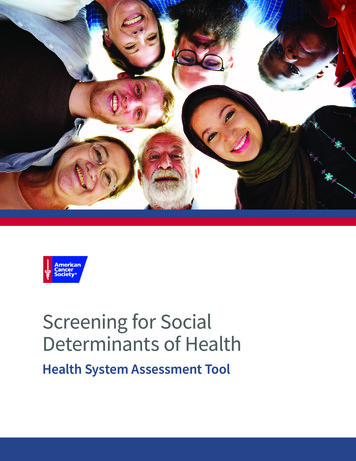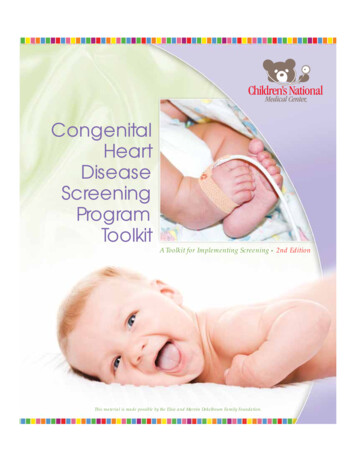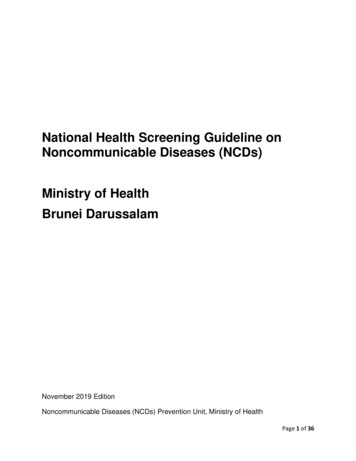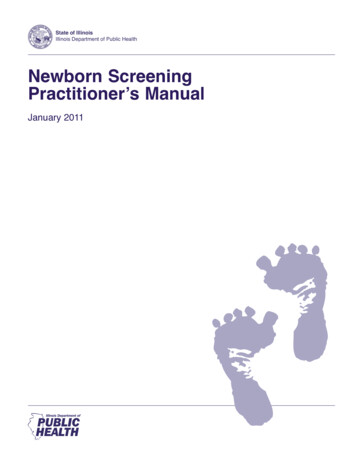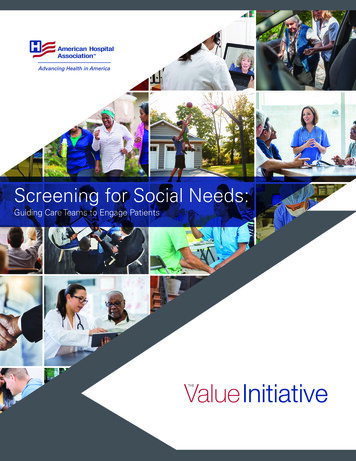
Transcription
Screening for Social Needs:Guiding Care Teams to Engage Patients 2019 American Hospital Association www.aha.org1
Screening for Social Needs:Guiding Care Teams to Engage PatientsTable of ContentsForeword. 3Background. 4Challenges in Screening for Social Needs. 4Guiding Principles for Screening. 6Implementing Social Needs Screening. 7Patient-centered Conversations about Social Needs. 9Referral Process for Positive Screens. 10Tailoring Screenings. 11Strategies to Scale Screenings. 11Conclusion. 13References. 14AppendixAHA Resources on the Social Determinants of Health. 15Referral Tools for Positive Social Needs Screens. 15Skill-building Tools for Patient-centered Conversations. 16Case Study: Baylor Scott & White Health. 17Case Study: Integrated Healthcare Associates, Trinity Health. 19 2019 American Hospital Association www.aha.orgJune 20192
ForewordOver the past year and a half, the American HospitalAssociation’s (AHA) effort, The Value Initiative hasbeen working with hospitals and health systemsaround the country to help improve affordability andpromote value. As part of that work, we have identifiedand shared proven strategies to help hospitals lowercosts, improve outcomes and enhance the patientexperience.A broad variety of value-based strategies includetaking action to address the social determinants ofhealth. Hospitals are addressing social determinantsin a number of ways. They have partnered withrideshare companies to ensure patients keep followup appointments, stocked their own food pantries with healthy options, and even invested in affordable housing,among other important efforts. This is complex and nuanced work that involves stakeholders in the public andprivate sectors. It begins with understanding patients’ lives beyond the walls of the hospital and addressing theirsocial needs.To treat patients’ social needs, we must first identify them through a screening process. In our work through TheValue Initiative, we have heard first hand from hospital and health system leaders that screening for social needsis challenging. For example, hospital care teams may feel uncomfortable engaging in conversations about socialneeds, there may not be enough time in a patient encounter to collect social needs information, or in some cases,patients are reluctant to discuss their social needs.This tool will help guide hospital leaders as they navigate the best wayto engage their patients in screening conversations. In addition, weknow that addressing the social needs of individuals and communitiestakes more than a screening conversation. It requires communitypartnerships. Hospital care teams also will need workflows and referralprocesses, among other things, to respond when a patient screenspositive for a social need. But, it does all start with a conversation.We hope this tool is helpful in those screening conversations and thatyou tap into AHA’s other tools and resources aimed at addressing thesocial determinants in our communities. For more information andadditional resources, please see the Appendix and visitwww.aha.org/ValueInitiative. 2019 American Hospital Association www.aha.org3
Screening for Social Needs:Guiding Care Teams to Engage PatientsBackgroundAs hospitals and health systems work to drive valueby enhancing the patient experience, improvingoutcomes and reducing cost, they are recognizingthe necessity of addressing the myriad nonmedicalfactors that affect health. An individual’s ability toachieve good health is influenced by more thanaccess to high-quality medical services; 80 percentof health outcomes are shaped by the socialdeterminants of health – the conditions in whichpeople are born, grow, work, live and age.1 Thesefactors include safe and stable housing, access tofood and transportation, social connection, safetyand environmental exposures.2 Social determinantsof health disproportionately impact vulnerablecommunities, contributing to the persistence ofhealth inequities.Social determinants and social needs are interrelated yet distinct concepts. Efforts to address the socialdeterminants of health focus on the underlying systemic social and economic conditions in which people live thatprevent individuals and communities from achieving their highest potential for health. Interventions to addresssocial needs are done at the individual level to mitigate unique acute social and economic challenges.Addressing the full scope and complexity of social determinants of health is a massive, multi-sector undertaking.As cornerstones of their communities, hospitals and health systems play a key role – in partnership with othercommunity stakeholders – to positively impact the social needs of the individuals they serve by screening for andaddressing the needs of their patients. A crucial step to addressing patients’ social needs is having a conversationwith individuals and families to understand what they are experiencing outside the exam room walls.A comprehensive social needs screening strategy has numerous components; this tool focuses on one piece –how care teams can engage patients in conversations about what they are experiencing and the importance ofaddressing their social and environmental needs. It offers strategic considerations and principles for how hospitalsand health systems can employ patient-centered strategies to have meaningful and empathic discussions aboutsocial needs. The tool also provides case studies of organizations at the front edge of this work.Challenges in Screening for Social NeedsIn a national survey of hospitals, 88 percent of respondents reported screening for social needs, yet a quarter of thescreenings are performed only occasionally on a select population.3 While there are many reasons for this, somepersistent provider-side barriers to screening for social needs include: 2019 American Hospital Association www.aha.org4
Discomfort engaging in conversations aboutsocial needs. Some clinicians feel uncomfortableinitiating conversations about potentially sensitivesubjects, such as social needs. They worry thatpatients will perceive the questions as intrusive oroffensive if not broached in an empathic manner.4 Insufficient time for collecting social needsinformation. Given limited appointment time,expertise and lack of compensation for screening,providers tend to prioritize medical issues oversocial needs.5Driving Value by Addressing Social NeedsThe American Hospital Association’s The ValueInitiative is addressing affordability throughthe lens of value. The AHA expresses valueas a complex concept comprised of improvingoutcomes, enhancing the patient experienceand reducing cost. By addressing patients’social needs alongside their medical ones,hospitals have the opportunity to positivelyimpact each component of the value equation. Lack of systems to document and track socialneeds data. Hospitals may not have a standardizedprocess for documenting social needs or trackingreferrals. Perceived lack of efficacy to address socialneeds. Clinicians may question whether they canimpact their patients’ complex underlying social,behavioral and economic conditions that are beyondtheir control and sphere of influence.6 A RobertWood Johnson Foundation survey found that fourout of five physicians do not feel confident in theirability to meet their patients’ social needs andapproximately half of physicians feel ill-informedabout the resources available.7Patients also may be reluctant to discuss their socialneeds with anyone, including their care provider. There arenumerous reasons that an individual may be hesitant toshare their social needs, including: Shame for not being able to provide for their family; Fear of what the provider will do with thatinformation; for example, that their children mightbe taken away, that they will not be able to stay intheir home, or that they might be treated differently; Stigma of others thinking less of them for needingextra support; Trauma may make it challenging to talk aboutdifficult situations in their lives; Power dynamics may create a perception thatpatients have less power than their clinician andinhibit their active disclosure of information; and 2019 American Hospital Association www.aha.orgFor example, Advocate Aurora Healthimplemented a nutrition screening andeducation program for adult patients at-riskor malnourished at four of its hospitals thatled to better outcome and lower costs. Theprogram yielded significant reductions in 30day hospital readmission rates and reducedaverage lengths of stay by almost two days.Health care costs were reduced by 3,800 perpatient and the program achieved over 4.8million in savings.8Additionally, University of Illinois Hospital’sBetter Health Through Housing programrecently reinvested funds to establishsupportive housing options for chronicallyhomeless patients that frequent theemergency department (ED). Working with acommunity partner, Center for Housing andHealth, patients accepted into the programare located by an outreach worker, andtransitioned within a few days into bridgehousing. From there, they are assigned to ahousing case worker at one of 27 supportivehousing agencies, who helps them select asuitable permanent supportive housing unit.Through this program, the hospital reduced EDutilization by 57 percent, and health care costsby 21 percent for this population.95
Social and cultural norms shape how different cultures viewsharing struggles and getting support for social needs.The challenges on both the provider and patient sides point to anopportunity to enhance how hospitals screen for social needs. Bydeveloping a systematic process that trains care team members to beempathic and inclusive, patients and care team members may be moreinclined to work together to meet medical and social needs.Guiding Principles for ScreeningThere is no one-size-fits-all strategy for social needs screening. Each hospitalshould adapt its approach based on its specific operational and communityneeds; all hospitals should consider how to incorporate the guidingprinciples described in Table 1 into their social needs screening strategies.Table 1. Guiding Principles for Social Needs ScreeningsEmpathy. The ability to understand andshare the feelings of another.Empathy builds connections between clinicians and their patients to betterunderstand their life circumstances and emotions. It allows the clinician to listen andreact nonjudgmentally to the patient’s challenges.Respect. Regard for the feelings, wishes,rights or traditions of others.Demonstrate respect by considering patients’ willingness to share their challengesrelated to socioeconomic risk factors. Asking patients about their prioritiesdemonstrates respect for their wishes and goals.Autonomy. The right of patients to makeindependent decisions about their care.Respect individual autonomy to make decisions about what social support they wantto accept. The patient’s choice is critical in seeking his or her buy-in for the screeningprocess and any subsequent actions.Trust. The reassuring feeling of confidencein the clinician.Build trust with patients to reduce the barriers discussed above; this enables aclinician to gain insight into a patient’s life circumstances and priorities, and elicittheir on-going input on their health status and social needs. Key traits relatedto trust include competence, compassion, privacy, confidentiality, reliability and10communication.Dignity. Sense of self-respect.Recognize patients as an equal, value their needs, inform them about their medicaldiagnoses and social risk, recommend treatment, but give them the right to makedecisions.Collaboration. Working with someone tocreate an outcome.Partner and foster relationships with community stakeholders to develop strategiesthat meet the unique social needs of patients and community members.Support. The act of helping or assistingsomeone.Show support by valuing patients’ priorities, giving them time to comprehend theirhealth and social needs, and respecting their decision to seek help, based on theirpreferences.Sensitivity. An appreciation of others’feelings.Recognize the sensitivities associated with individuals being asked to sharetheir deepest concerns. Build a safe environment for patients to share their lifecircumstances.Cultural Competence. Being respectfuland responsive to the health beliefs andpractices of diverse population groups.Recognize the diversity of the community and establish a culture where cliniciansacknowledge that societal norms and attitudes towards health are grounded inculture. Leverage this openness to empower individuals to address their health andsocial needs in a culturally appropriate manner.Community-engaged. The process ofworking collaboratively with communitygroups and members to address issues thatimpact the well-being of those groups.Prioritize engaging patients and the community the hospital services by partneringwith community organizations and listening to the life experiences of communitymembers to gain insight on community needs as well as assets.Source: American Hospital Association, 2019. 2019 American Hospital Association www.aha.org6
Implementing Social Needs ScreeningSocial needs screening approaches should be unique based on the needs and preferences of the organizationand community. Hospitals need to determine which approaches best fit their needs. Here are four components toconsider in the design and implementation of social needs screening strategies.Co-designing the Screening ProcessCo-designing the social needs screening approach creates an opportunity to collaborate with providers, patients andcommunity stakeholders. Providers. Collaborating with clinicians to create the screening tool fosters a sense of ownership of thequestions and process. They can apply their expert knowledge of their patient population and clinicalprocesses to ensure that the social needs approach dovetails with their clinical work. Patients. Individuals are experts in their own experiences and culture, and can provide valuable insight intohow clinicians can discuss social needs with others in their communities and the most important questionsto ask. Community stakeholders. Community-based organizations have expertise in the communities they serve.Collaboratively designing the social needs screening process can strengthen the partnership between thehealth care organization and the other community stakeholders. It is important to invest the time to buildand maintain relationships with community stakeholders since they are essential partners for addressingidentified social needs. Hospitals and their community partners should be sensitive to each other becomingoverwhelmed by an increase in positive screens for social needs and referrals.Creating the Conditions for ScreeningThere are numerous locations, modes of communication and points of contact throughout the patient encounterwhere providers can screen for social needs. While each of the following approaches can add value, the co-designprocess should help inform which of these methods is be best for your hospital’s population. Locations. Hospitals can screen patients in anoffice space, exam room or electronically fromtheir home. Screens conducted electronicallyat home can be followed up on during theirvisit. Screenings should be done in a privatesetting where the patient is able to talk openlywithout being overheard.At Chicago’s Rush University Medical Center,care team members ask patients questionsabout social determinants of health in theED and across the Rush system. Patients’responses are entered real time into the socialdeterminants of health screening tool, whichis integrated into their electronic health records. This method gives the care team member the ability toaddress patient needs expediently and connect patients to community resources via text and email, as wellas provide direct referral to some partner agencies. 2019 American Hospital Association www.aha.org7
Modes of communication. Hospitals can inquire about their patients’ social needs on paper, electronicallyand/or through in-depth conversations. Screening questions can simply be incorporated into existing healthassessments that patients fill out. The medium also may vary by the social need being asked about; forexample, patients may be more willing to disclose household violence or substance use disorders in anelectronic format than in conversation.11 Point of contact. The care team can engage in conversationsabout social needs before, during and after a patient encounter andin multiple settings. Settings will vary based on an organization’sworkflow, patient volume, availability of care team members andaccess to a private space.Boston Children’s Hospital established a Community AsthmaInitiative in 2005 to address social determinants and reduce asthmahospitalizations and ED visits, which are disproportionately high forAfrican-American and Latino children. Families of children enrolledin the program receive home visits and environmental assessmentsto identify and reduce asthma triggers. In addition, nurse-supervisedcase managers connect families to local resources for educational,financial and housing support as well as programs that promotephysical activity.Regardless of where or when the screening takes place, hospitals shouldensure that there is sufficient time to connect with patients, so as not tomake the process feel rushed.Screening ToolsNumerous tools offer screeningquestions that can be integratedinto an electronic medicalrecord. The Social InterventionsResearch & Evaluation Network(SIREN) summarized themost widely employed socialneeds screening tools, suchas the Protocol for Respondingto and Assessing Patients’Assets, Risks and Experiences(PRAPARE) and AccountableHealth Communities Tool, whichcan be used to help hospitalssuggest screening questions oradapt existing screening tools.Identifying the Right Care Team Members to Conduct the ScreensHealth care providers are uniquely positioned to talk with individuals about their social needs. Not only can theyidentify social needs during a patient visit, they can address clinical needs that stem from social needs, follow up onfuture visits and ensure that the referral loop is closed. Yet physicians are not the only care providers who can – orshould – discuss social needs with patients. Other care team members include nurses, medical assistants, patientnavigators, community health workers (CHW) and social workers. In fact, CHWs may be well positioned to workwith patients around social needs by allowing them to work with someone from their community who understandstheir daily realities.The Women-Inspired Neighborhood (WIN) Network at Henry Ford Health System, in Detroit, is a neighborhoodbased infant mortality reduction program where CHWs co-facilitate group prenatal care sessions with certifiednurse midwives. As part of their first contact with mothers, CHWs help mothers complete a needs assessmenttool, discuss and offer necessary support services in the community for priority needs and help them identifyresources for which they are eligible. Through this process, CHWs form a relationship with mothers as theybecome their point of contact throughout the pregnancy and help track and achieve the patient’s goals related toimproving the health of the individual and baby.Documenting Social NeedsThe field continues to advance its approach to standardizing documentation for social needs. Screening resultsshould be routinely and consistently documented in the medical record so that it can be incorporated in thetreatment plan. ICD-10-CM codes allow the care team to electronically code for social needs reported during the 2019 American Hospital Association www.aha.org8
assessment process. Results of the screen should be accessible to all care team members. According to thepatient’s identified need, establish a screening frequency to determine any changes in patient’s conditions from thefirst assessment, as suggested in HealthBegins’ screening tool.Patient-centered Conversations about Social NeedsProviders regularly have conversations with their patients about their medical conditions; however, given thesensitivity around social needs, patients and families need to be asked the right questions in the right way toengage them and elicit their stories. In other words, patients will be more inclined to share their life circumstancesin a safe, nonjudgmental environment where their care team members exude compassion, openness and empathy.This approach creates an opportunity for hospitals to build trust,better understand patient needs and deliver patient-centered care.As hospitals implement social needs screening that includessensitive questions, providers should be supported in theircrucial role in identifying and addressing social needs and waysto establish trust and respect among care team members andpatients. Table 2 features approaches that can support careteams in asking sensitive questions about social needs. See theAppendix for corresponding tools.Table 2. Skills for Engaging in Sensitive ConversationsApproachDescriptionCultural Competency. The ability tointeract effectively with people fromdifferent cultures.Cultural competency training helps care team members increase their sensitivityto cultural diversity, reduce language barriers and build understanding for life12experiences that shape a person’s identity.Motivational Interviewing. Counselingmethod that helps people resolvechallenges and find the internal motivationto change their behavior.Motivational interviewing empowers patients to take control of their own health and13behaviors by setting goals based on their wishes and current circumstances.Active Listening. Technique where thelistener fully concentrates, understands,responds and remembers what is beingsaid.Active listening teaches providers how to properly listen to what patients are saying,identify any underlying hesitance and in return ask leading, open-ended, closedended and reflective questions related to their challenges.Empathic Inquiry. The technique thatintegrates motivational interviewingand trauma-informed care to facilitatecollaboration and emotional support.Empathic inquiry trains care team members to connect with patients, increaserelatability and suggest nonjudgmental approaches to improve health.Asset-based. An approach to care thatfocuses on the individual’s strengths andpotentials.Recognize that, alongside having needs, patients and communities have manyassets that can be leveraged to address their social needs. An asset-based approachallows the provider-patient conversation to be reframed from a focus on deficits toconnecting with their strengths, interests and areas the patient fiends meaningful.At the community level, an asset-based approach helps identify, partner with andleverage resourceful organizations such as schools, community-based or faith-basedorganizations, government, local businesses, etc., and people in the community tocollectively build on existing resources and form new community connections.Trauma-informed. A framework thatinvolves understanding and responding tobehaviors/actions and needs as a result oftrauma.Trauma-informed care is a holistic approach of treating a patient, where it is assumedthat each individual has a history of trauma and coping mechanisms. Integratequestions and practices that are trauma-sensitive to increase resiliency and build a14culture that supports personalized patient care.Source: American Hospital Association, 2019. 2019 American Hospital Association www.aha.org9
Referral Process for Positive ScreensHospitals should have an established workflow that is responsive when a patient screens positive for a social needthat includes: Define roles and responsibilities of the care team members. Leverage the expertise of otherprofessionals (e.g., social workers, community health workers, community benefit, IT, etc.) within thehospital with knowledge on referrals, community relationships, data, etc. Empower the care team withtools, skills and time to learn, implement and track the screening and referral process. View workflowexample from VCU Health System. Create a centralized system to capture data and incorporate coding the results of patient screens into anelectronic medical record system. Learn about coding for social needs. Foster partnerships with community-based organizations to create a referral network, raise awarenessabout services provided and bridge any gaps in care. Refer to A Playbook for Fostering Hospital-CommunityPartnerships to Build a Culture of Health to identify key community partners. Develop a referral and community resource database. Integrate the inventory of community resourcesinto a web-based or software system to generate and better track referrals. Close the referral loop by developing a bidirectional process, where the care team follows up with thepatient to see if the referral was received and then again in one-two weeks to ensure needs were met.Develop a system to track referrals and measure the success of the screening and referral process. In orderto facilitate referrals, technology is being developed to connect individuals with the resources they need.Organizations involved in this work include NowPow, Health Leads, 2-1-1 and Healthify.View the Appendix for electronic tools and local resources hospitals can use to connect patients with identifiedneeds to community resources.Empathic Inquiry: Screening SensitivelyThe Oregon Primary Care Association (OPCA), a nonprofit membership association for Oregon’s federallyqualified health centers, created Empathic Inquiry as a conversational model for social needs screening thatpromotes partnership, affirmation and patient engagement. Empathic Inquiry was developed through thesynthesis and application of input from patients and other stakeholders, along with key concepts and skillsfrom motivational interviewing and trauma-informed care. The pilot training program provided in-person trainingand remote support to nurses, medical assistants and community health and outreach workers from 10Oregon community health centers in 2018. Survey results from training participants showed improvements inconfidence and comfort in conducting social needs screening, as well as perceptions of patient partnership andautonomy. Similarly, patient experience surveys revealed the following: Patients agree that the empathic inquiry conversation strengthened their relationship with their care team(64 percent strongly agree and 28 percent somewhat agree). Nearly all patients agreed that the conversation was a good use of their time (83 percent strongly agreeand 14 percent somewhat agree). More than 70 percent of patients said, “After my conversation today, I know more about how the cliniccan assist me with needs beyond medical care.” 2019 American Hospital Association www.aha.org10
Tailoring ScreeningsTo ensure a hospital’s social needs screening approach aligns withtheir unique organization and community, hospitals should considerthe strategic approaches outlined in Table 3 to determine how best tocustomize their approach.Strategies to Scale ScreeningsAs hospitals build their social determinants strategies, they are usingdata to scale screenings outside of the local health system and into thecommunity to identify community needs, better detect associationsbetween social factors and health outcomes, and implementpopulation health programs. Below are some strategies hospitals canadapt to extend social needs screenings beyond their walls. Start small. Pilot a screening approach such as holding anopen forum or community dialogue to learn and engage withcommunity members. As the screening process is implemented,continue to observe what does and does not work and makeadjustments accordingly. Know the community. Continue to learn about the patientpopulations served by analyzing data from screenings, medicalrecords, claims and community health needs assessments. Raise awareness. Develop internal engagement strategies tosupport work around social needs. Train. Continue to train care team members on culturalcompetency, motivational interviewing and empathy to reducestigma around speaking about social needs. Refer to Table 2 forexamples of practices. Collaborate. Strengthen existing relationships with communitystakeholders and build new ones to develop population healthprograms around prominent social needs in the community. Thisis not the job of one organization alone. 2019 American Hospital Association www.aha.orgScreening for Social Needs in theCommunityL
Addressing the full scope and complexity of social determinants of health is a massive, multi-sector undertaking. As cornerstones of their communities, hospitals and health systems play a key role - in partnership with other community stakeholders - to positively impact the social needs of the individuals they serve by screening for and


